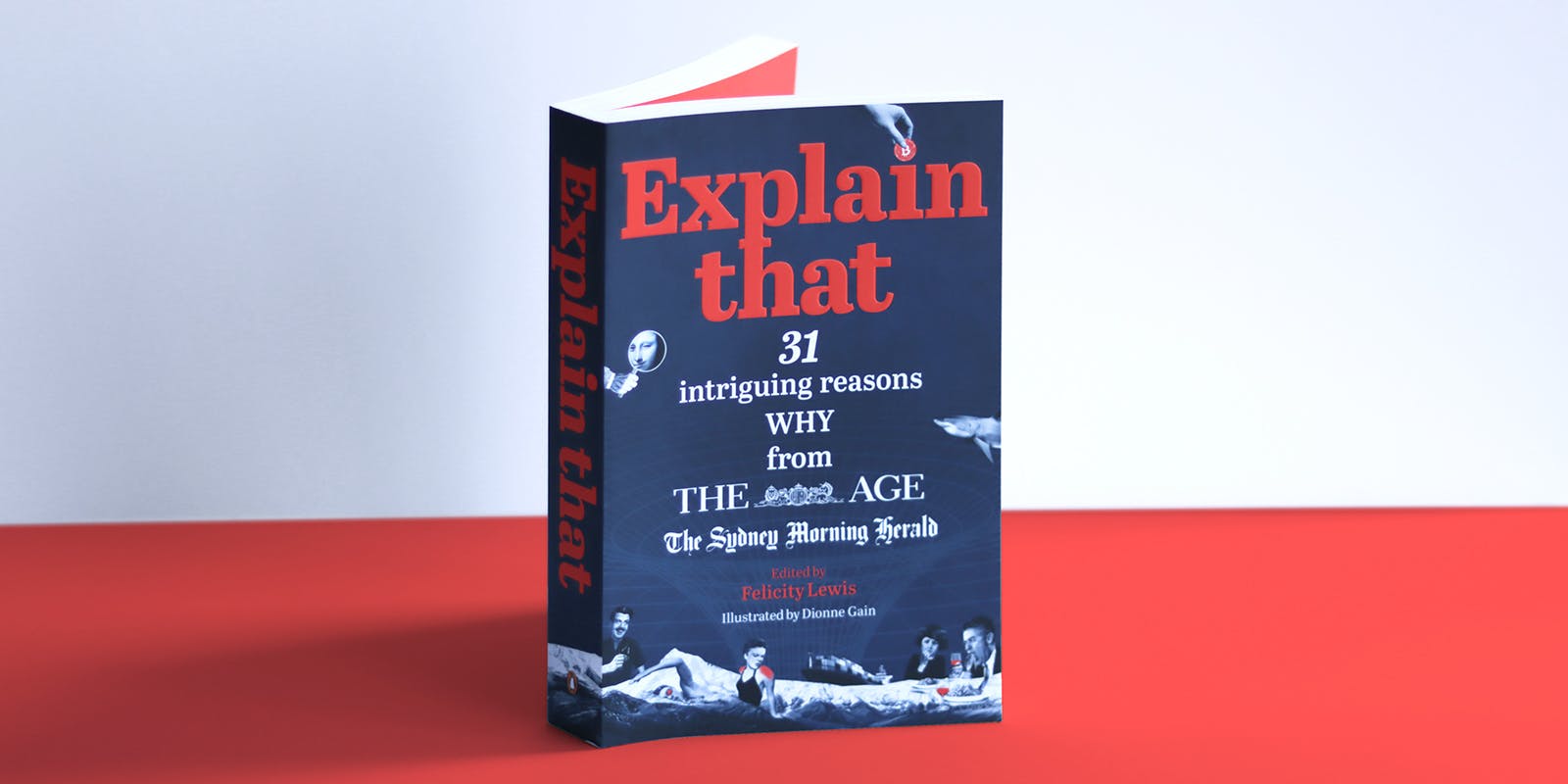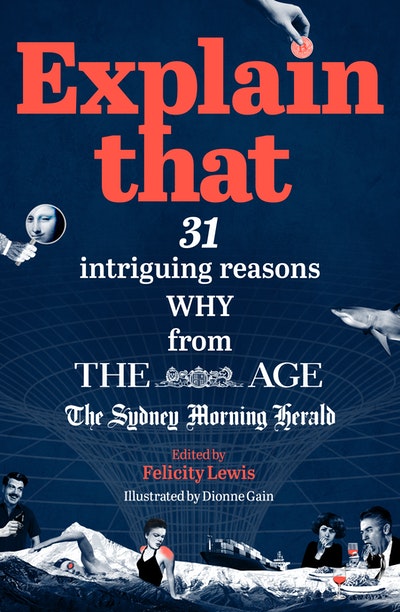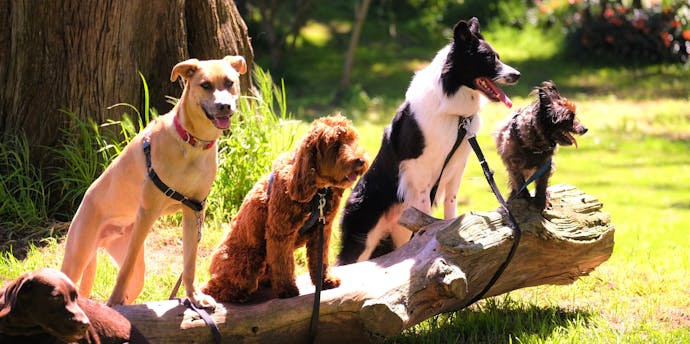Can a chemical reaction in your brain really decide your romantic future? Or have we been sold a fairytale?
For the ever-curious, the trivia buffs and those who love to learn, Explain That is the book for you. Editor Felicity Lewis has gathered together this collection of thought-provoking explainers from The Age and The Sydney Morning Herald to answer some of the year’s – and life’s – most baffling questions. What makes Australia's wildlife unique? Is time travel possible? What are cats and dogs thinking?
'We aim to give our readers clear and interesting explanations of concepts, buzzwords or events in the news and in life – to get to the guts of an issue without sacrificing the nuance. If you’ve enjoyed getting to grips with a topic through reading one of our explainers and you’ve come away with some pithy facts to share with family and friends, then we’ve done our job,' says Lewis.
In the passage below we dive into whether love at first sight exists. Take a sniff of a prospective lover next time to see if they're right for you...
It happened in an instant: our eyes met across the dance floor and we moved towards one another. Something pulled us closer together.
‘What’s your name?’ I asked with the confidence of a 24-year-old who had zero expectations of meeting anyone, let alone a romantic partner, at a rave party at 3am on New Year’s Day.
‘Nick,’ he replied. ‘What’s yours?’
It was his eyes and then his smile that drew my body closer to his. We danced until the sun came up. Then we went our separate ways and, as with all great millennial romances, a friend request on social media followed. By April, we were Instagram official.
Had the universe been turning its gears, preparing us both for that moment on the dance floor? Did the stars finally align? Perhaps it was simply potluck. All I know is that seven years later, we have married and, yes, we are very much in love.
My experience is far from unique. Poetry, novels, music – all kinds of art – have popularised the phenomenon of love at first sight for centuries. But what is it, how do we measure it? Does it even exist? What happened on the dance floor that night? And was a romantic relationship inevitable?
What is love at first sight?
One hundred milliseconds – that’s precisely how long it takes to evaluate a potential sexual partner. And if, after that split second, you deem that person to be attractive, emotions will begin to kick in as well as some animal-like instincts.
Anthropologist Helen Fisher explored the process of communicating our attraction to another person via a copulatory gaze in her book Anatomy of Love, first published in 1992. ‘The gaze is probably the most striking human courting ploy,’ Fisher writes. In cultures where eye contact between the sexes is permitted, ‘men and women often stare intently at potential mates for about two to three seconds during which their pupils may dilate – a sign of extreme interest. Then the starer drops his or her eyelids and looks away.’
So what is it that makes our pupils dilate? What is it that triggers a snap judgement that could lead to a romantic connection?
Unsurprisingly, looks matter. Studies reveal we are sexually attracted to people who look like us. In 1999, researchers asked subjects to rate pictures of faces morphed with their own and found the subjects each rated the morphed faces as being more attractive. Other physical traits can also seal the deal: ‘Men and women around the world are attracted to those with good complexions. Everywhere people are drawn to partners whom they regard as clean. And men in most places generally prefer plump, wide-hipped women to slim ones,’ Fisher writes.
The medial prefrontal cortex, near the front of the brain, is responsible for such judgements. Researchers in Dublin discovered that one particular area of this region – the rostromedial prefrontal cortex, a segment located lower in the brain – goes one step further in evaluating physical attractiveness by asking, ‘Is this person a good match for me?’ This is the same brain region known to be important in social decisions, particularly how similar someone is to you, the study’s authors explained. Essentially, we are evaluating someone’s attractiveness in those initial milliseconds while also determining their compatibility.
But it’s all very unromantic, really, says Trish Purnell-Webb, a clinical psychologist at the Relationship Institute Australasia. ‘When we’re looking to mate, the brain will constantly search the environment and look for another person who will be a good mate and make strong babies.’
You like what you see, so what happens next?
There is a surge in the attachment hormone oxytocin, says Purnell-Webb. Oxytocin stimulates the secretion of other neurotransmitters – molecules that act as chemical messengers – such as dopamine which fires up the brain’s reward centres.
At this point, you begin to focus more intently on that person and there will be a spark of interest in your eyes. ‘Imagine a dog pricking up its ears when it senses its master has returned home – that’s what a person who is experiencing attraction is like,’ says Purnell-Webb, adding that generally it’s subtler than with dogs, although not always.
Often called the ‘cuddle hormone’, oxytocin compels us to get close; when we are feeling close to somebody else, we secrete more of it. ‘Oxytocin is actually the hormone for poor decisionmaking,’ says Purnell-Webb. ‘It makes you become a bit obsessed and compulsive. You’re being driven to try and make contact and attract the same interest back.’
The more signs you get from the other person that they are interested in you, the more oxytocin is released. It’s during this time that we often feel like our heart is racing, our palms get sweaty or we have butterflies in our tummy, says Gery Karantzas, the director of Deakin University’s Science of Adult Relationships Laboratory. ‘It’s why we often hear love being referred to as a drug,’ says Karantzas. It’s a virtuous circle and a delicious cycle.‘You develop these strong feelings for someone, particular parts of your brain get activated when you spend time with them, you therefore want to spend more time with them, which then releases more of these chemicals, and you feel more of those feelings and so on.’
Similar brain areas fire up if you take cocaine, as Fisher discovered in a groundbreaking experiment: she did MRI scans on 37 people who were madly in love, which showed a surge of activity in brain areas rich in dopamine. ‘But romantic love is much more than a cocaine high – at least you come down from cocaine,’ Fisher said in a 2014 talk. ‘Romantic love is an obsession, it possesses you. You lose your sense of self.’ You can’t, she adds, stop thinking about that other human being.
What’s love at first sniff?
Pheromones – which are, essentially, scented chemicals that act like hormones outside the body – allow us to literally sniff out a potential match. Think of them as a primal form of communication; smell plays a major role in sexual attraction and can even trigger ovulation. But here’s the thing: pheromones smell different to different people. ‘Male pheromones are often described as having a woody or musky smell while female pheromones smell more floral or sweet,’ says Purnell-Webb. At other times, depending on who is sniffing whose pheromones, they can smell bitter, sweaty or like stale urine. Some studies have suggested that, during ovulation, women are highly sensitive to the musk-like pheromones that men secrete.
As you continue to smell the other person, attraction builds and you move closer to them. Are you looking for anything in particular? Not really. It’s more a case of beauty being in the eye of the beholder, says Purnell-Webb. ‘We all have particular personal preferences, some people like beans, others peas,’ she says. There is some evidence to suggest attraction is part of our genetic imperative – our genes determine who and what we are attracted to – which raises the question, is there a perfect match out there for each of us?
That’s the premise of the Netflix show The One, set ‘five minutes into the future’, in which finding a soulmate is as simple as snipping off a strand of hair and posting it to a DNA matchmaking company. Because the company claims to find perfect matches on a genetic level, attraction is inevitable, actually involuntary. Upon first meeting, the match smells right, looks right and demonstrates all of the right characteristics. They also taste really good.
A 2000 study by Swiss biological researcher Claus Wedekind found that when we kiss we exchange a heap of biological and genetic information. Women tend to be more attracted to men whose MHC (major histocompatibility complex) genes, which are essential to the immune system, are different from their own. Having different genes produces offspring with stronger immune systems. Wedekind is best known for his 1995 ‘sweaty T-shirt study’, which had a similar upshot but involved women sniffing T-shirts that had been worn for two days by male students using no deodorant – they preferred the odour of men with different MHC genes to their own.
No one has conducted a T-shirt-sniffing exercise to examine how same-sex participants are magnetised towards some people but not others. However, a large genetic study into the underpinnings of same-sex attraction, whose findings were released in 2018, had researchers identify four regions in participants’ genomes that influence a person’s choice in sexual partner. Two were observed in men and women, and two were seen in men alone. The DNA identified could account for only 8 to 12 per cent of the genetics behind non-heterosexual behaviour. One of the variants was linked to the olfactory receptor.
Sniffing unwashed T-shirts is the human equivalent of dogs sniffing each other’s sweat glands (which happen to be located in their rear ends), says Purnell-Webb. Romantic, no? And kissing, for its part, may well be the most glamorised exchange of chemical information known to humans. It also explains why some people are immediately turned off after the first whiff (or kiss) while, for others, the intensity of attraction and desire only grows.














